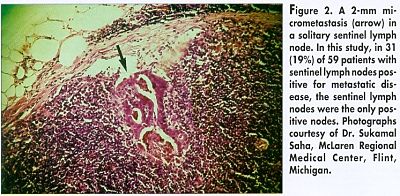Mapping Predicts Nodal Status in Colorectal Cancer Patients
NEW ORLEANS-A prospective study in colorectal cancer patients has found that sentinel lymph node (SLN) mapping correctly predicts the presence or absence of nodal metastases, with a very low incidence of skip metastases (disease in a non-SLN), as it does in melanoma and breast cancer.
NEW ORLEANSA prospective study in colorectal cancer patients has found that sentinel lymph node (SLN) mapping correctly predicts the presence or absence of nodal metastases, with a very low incidence of skip metastases (disease in a non-SLN), as it does in melanoma and breast cancer.
At the Society of Surgical Oncology Cancer Symposium, Michigan State University researchers presented data on 168 consecutive colorectal cancer patients who underwent SLN mapping (see Figures 1 and 2).


Exclusive sampling of the sentinel nodes correctly predicted the presence or absence of lymph node metastasis in 96% of the cases, reported Sukamal Saha, MD, assistant professor of surgery and anatomy, McLaren Regional Medical Center, Flint, Michigan.
Multiple studies have shown that up to 30% of stage I and II colorectal cancer patients will develop metastatic disease within 5 years of diagnosis. We believe this is largely due to pathologic under-staging of nodal micrometastases, Dr. Saha said.
Furthermore, he said, studies have shown that about 70% of involved lymph nodes are under 5 mm in size, and it is possible that a cursory examination of the lymph nodes may indeed miss small metastases.
If we can identify the first few nodes where most of the metastatic disease could lodge, he said, then, with careful pathological examination using microsection-ing, H&E [hematoxylin and eosin] staining, immunohistochemical staining, and PCR techniques, we may enhance the diagnosis of micrometastatic disease and give adjuvant therapy to these upstaged patients.
In the study, SLNs were sectioned at intervals of 20 to 40 microns at 10 levels and stained with H&E, then immuno-histochemically stained for cytokeratin and carcinoembryonic antigen (CEA). In addition, standard pathological examination of the remaining non-sentinel lymph nodes also was done.
To assure that any increased detection of micrometastases in the SLNs was not due solely to this increased sampling, all initially negative non-SLNs in the first 25 patients were also sectioned at 10 levels.
The SLN was identified in 164 of 168 patients (98%); one, two, or three sentinel lymph nodes were found in 160 patients, or more than 95%. A total of 300 SLNs were identified out of 2,504 total lymph nodes.
Negative Predictive Value
In 98 patients (60%), the SLNs were negative for metastatic disease. In 91 of these patients (93%), all non-SLNs were negative as well. The negative predictive value, therefore, was 93%, Dr. Saha reported.
In 7 of these 98 patients with negative SLNs, other non-SLNs were positive, yielding a skip metastases rate of about 7%. But we presented consecutive patients, and we did not discard patients for any reason, Dr. Saha pointed out. Now, we know more about the limitations of this method, and which patients would not benefit. If we exclude patients who would not undergo this procedure in normal clinical practice, our skip metastases rate is closer to 4%.
In 59 patients, SLNs were positive for metastatic disease; 28 (17%) of these patients had additional non-SLNs that were positive. In 31 patients (19%), SLNs were the only nodes positive for metastatic disease, he said.
Most important, Dr. Saha said, in 28 of these 31 patients, micrometastatic disease was identified in only one, two, or three microsections of the 10 that were taken of a single sentinel lymph node. In 10 patients, this was discovered only by immunohistochemistry, as H&E was negative.
Such micrometastatic disease in 6- to 7-mm nodes could have been missed by standard pathologic examination, he said.
In the first 25 patients with negative SLNs, in whom all initially negative non-SLNs were sectioned at 10 levels, fewer than 1% of nodes were positive for metastatic disease. Similar studies were carried out in the first 82 consecutive patients, and again, when the SLN was negative, the incidence of finding metastatic disease in non-SLNs was only 1%, he emphasized.
By this mapping technique, more than one third of patients categorized as clinical stage I or pathologic stage I were upstaged to stage III disease.
A Short Learning Curve
Dr. Saha concluded, This is a viable technique with a short learning curve and minimal side effects. Its accuracy in identifying metastatic disease is 93%. It definitely allows the pathologist to focus attention only on one to four sentinel nodes.
Examination of only 12% of the nodes [the SLNs in this series] would have given the correct diagnosis in most patients, he said, allowing the pathologist to avoid examining 88% of the lymph nodes.
The main point is that when the SLNs are negative, the chance of missing cancer in the non-sentinel nodes is less than 1%, Dr. Saha continued. From a pathological point of view, you should bet on the sentinel nodes. The accuracy of your diagnosispresence or absence of metastasesis 96%.
Alfred Cohen, MD, chief of colorectal surgery, Memorial Sloan-Kettering Cancer Center, said that he remains concerned about the skip metastases rate, but called the presentation important and said he has been encouraging Dr. Saha to work with the American College of Surgeons Oncology Group on this project.
Newsletter
Stay up to date on recent advances in the multidisciplinary approach to cancer.